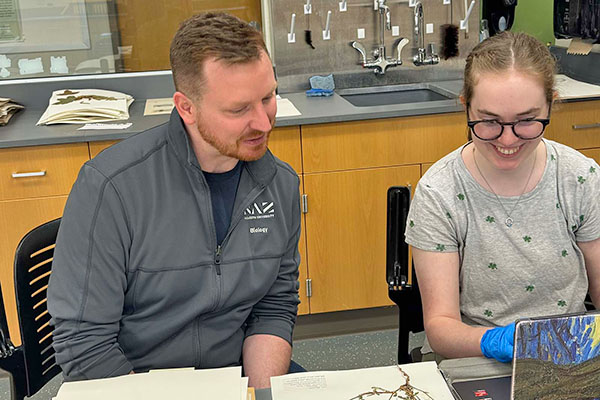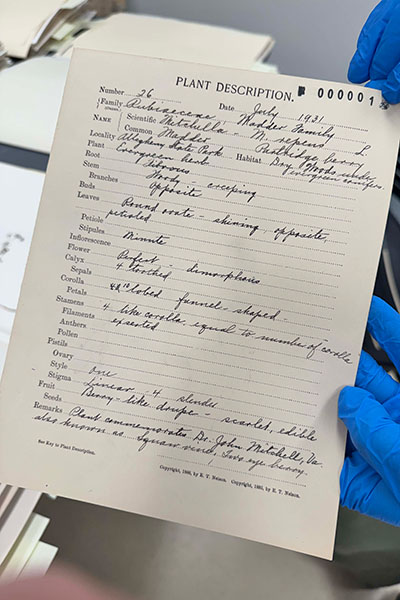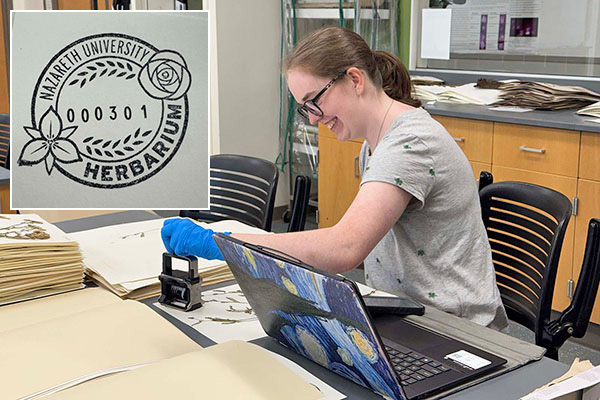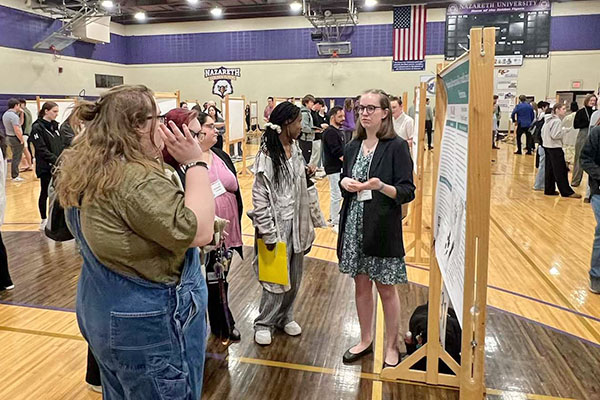Preserving a century of botanical history

Assistant Professor Patrick Garrett and student Amelia Burm look at her work on the Nazareth herbarium.
A chance stop at the Peckham Hall greenhouse while her parents were visiting for Naz Weekend turned into a hands-on internship for Amelia Burm ’26 that helped her preserve University and botanical history and gain a new skill set.
“We were heading back to my dorm during Naz Weekend, and my dad, who has always loved plants, wanted to stop to see what event was going on at the greenhouse,” said Burm. They ran into Assistant Professor Patrick Garrett, Ph.D., director of the environmental sciences and sustainability program. “He asked what my name and major were. I said that I am a double major in history and museums, archives, and public history.”
Her interest in plants, combined with her fields of study, made her a great candidate for restoring and reorganizing Nazareth’s herbarium, a collection of dried plant specimens started nearly 100 years ago by the Sisters of St. Joseph and Nazareth students. The plant specimens are from campus, the Rochester area, and places the sisters traveled, such as Washington, D.C.
“Botanists use herbariums to track plant species over time,” said Garrett. “Knowing a plant was here in 1950 and is still here today is very informative from a biological perspective. These types of collections have been pivotal in monitoring invasive species and species introductions or extinctions across the United States.”
After talking with her advisor, Burm signed on to work on the herbarium project to get hands-on experience and learn something new about plants while working in archiving before graduating.
“This project has allowed a crossover in science and archival work that is not usually seen in undergrad,” said Garrett. “The combination of biology and her museums, archives, and public history major is a unique skill set — not only to make a well-rounded student, but also in future archival work.”
Over the years, the collection has been organized and somewhat preserved, but Burm had her work cut out. She did extensive research into how an herbarium is run, the order of everything, and the functionality of different herbariums — helping her discover the importance of a physical herbarium.
“Herbariums are important not just in scientific research but also within the field of history. While online versions of herbariums are great, the physical herbariums allow researchers to see the plants in front of them and in some cases scientists will extract DNA from the plants to better understand how they have evolved or adapted to climate change over the years,” said Burm.
Burm’s curiosity kept it fun and educational. “I am proud of finding the oldest dated specimen in our collection, which is from 1931. We previously believed the collection started in the 50s, so being able to change the date to the 1930s was a cool thing for me.”
Burm, who wants to study archives in graduate school, has sorted most of the collection in alphabetical order by family name, then by genus and species. Getting a plant from field to lab is an extensive process.

Nazareth Herbarium’s first specimen description from 1931.

The herbarium stamp that Burm helped create (inset) and her using it as part of her work on the collection.
Plants are first collected from the field, brought back to the lab where they are put into a herbarium press to dry. From there the plants are mounted to herbarium paper with glue, then correctly identified. After being mounted they are placed into their family, then alphabetized within the family by genus and species.
While repairing and remounting plants that had been damaged or had fallen off old herbarium paper, she discovered that the adhesive of choice is one known to all ages.
“I thought it was so interesting that herbaria worldwide use Elmer’s glue to mount the plants because it’s archival safe or acid free — it won’t hurt the plant, the paper, or the other specimens. It also dries clear and is most cost-effective and easy to find.”
Burm even helped create a new stamp for the herbarium to use as new specimens are added to the collection. It includes two flowers that were recently finalists to be Nazareth’s official flowers, the trillium (native to our area) and a yellow rose, representing the University’s purple and gold colors.
After each plant has been mounted and sorted, it is put into the database. Then it is ready to be frozen before putting it into a metal cabinet where the collection resides for students and professors to use.
Frozen? “There are three main dangers a herbarium faces: fires, water, and bugs,” said Burm. “Our cabinet is fire- and water-proof, and sealed to keep bugs out. Bugs are a different story when the collection is out in the open because we may not see them get onto the specimen. So, before any plants go back in with the collection, we freeze them to kill any bugs and ensure the longevity of our herbarium.”
The herbarium now has a new number system and database for people to use when researching or working in the herbarium. Next steps include creating a website so researchers can search Nazareth’s collections for particular plants.
This is the first time the herbarium will be organized in the way that most herbaria worldwide organize their collections. Burm presented her work at Nazareth’s 2025 Creative Activity and Research Showcase, an annual college-wide symposium celebrating students' creative and scholarly work through posters, presentations, and performances.
“I have gained a whole new skill set that I would not have been able to get at another internship, and it will set me apart from people in both the archival and museum fields,“ said Burm. “I like knowing that the work I am doing is going to outlast me and will help educate future scholars.”

Amelia presenting her work at CARS — Nazareth’s Creative Activity and Research Showcase.